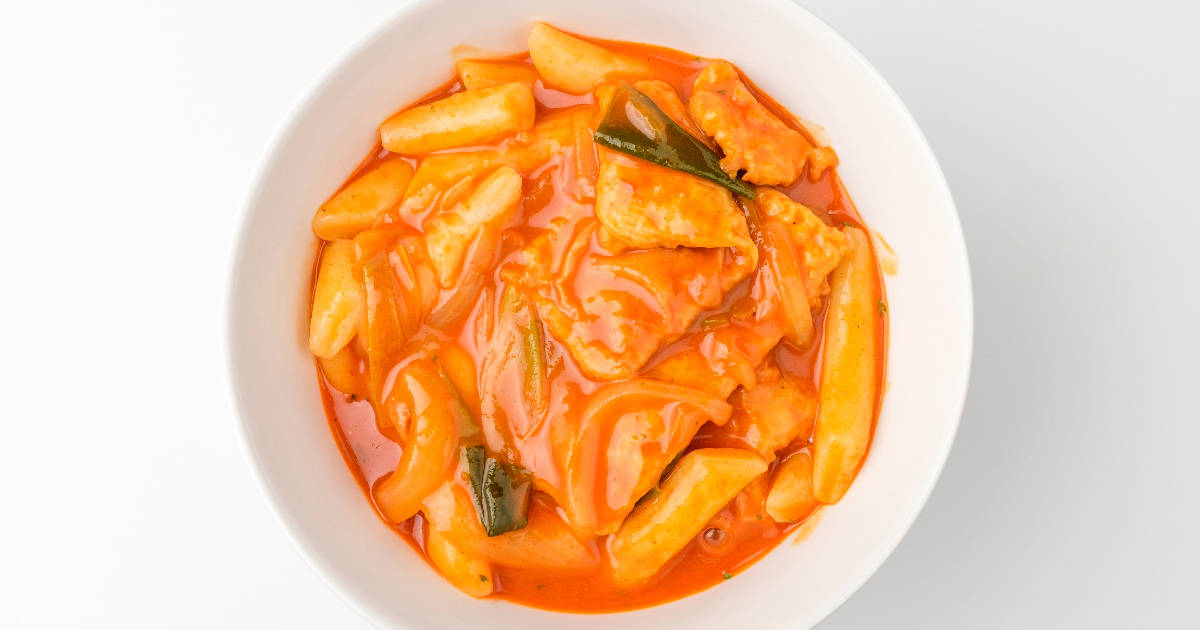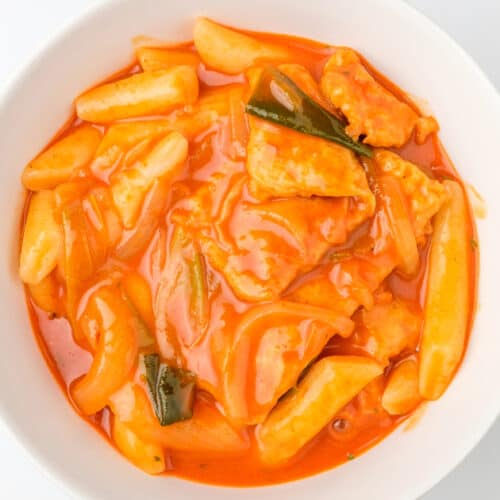Gochujang is the star ingredient that makes gochujang soup so deliciously spicy, savory, and satisfying. This thick, miso-like condiment is made from fermented soybeans, glutinous rice, and chili peppers. It adds a complex, sweet heat to dishes that are truly unique to Korean cuisine.

If you've never cooked with gochujang before, making gochujang soup is a great way to experience its flavor. The paste melts into the broth, infusing it with rich umami depth and just the right amount of kick.
Find Gochujang at an Asian Market or Online
While gochujang is becoming more mainstream, your best bet for finding it is at an Asian grocery store. Look for it in the refrigerated section, sold in plastic tubs. The color can range from deep red to brownish red.
If you don't live near an Asian market, purchasing gochujang online is easy. There are many Korean brands available on Amazon.
When you open your tub of gochujang, give it a sniff. It will have a sweet and fermented aroma. Taste just a tiny bit on your finger for an idea of its spicy-sweet flavor. A little goes a long way, so start with less when adding it to your soup.
Once opened, transfer any leftovers to an airtight container and store in the fridge for up to 3 months.
Gochugaru Adds Extra Heat
In addition to gochujang, many recipes for gochujang soup also include gochugaru. This is Korean red chili pepper flakes, which can ratchet up the heat level.
Gochugaru is also worth seeking out at an Asian grocer or online. The fine flakes have a bright, aromatic red color. Sprinkle them on toward the end of cooking so they retain their vibrancy and kick.
If you can't find gochugaru, you can substitute regular red pepper flakes. Just use about half the amount called for in the recipe.
Customize Your Soup with Various Proteins and Veggies
One of the great things about gochujang soup is how customizable it is. While recipes often include pork or seafood, you can use any protein you like. Chicken, beef, and tofu are all fair game.
For vegetables, favorites include potato, zucchini, onion, mushrooms, and leafy greens. Leafy greens like spinach or bok choy are best added toward the end of cooking so they retain their color and texture.
Feel free to swap different vegetables based on what you have on hand and your personal preferences. The gochujang will infuse them all with flavor.
A Simple Formula for Building Flavor
At its core, gochujang soup has a simple formula.
- Aromatics - Start by cooking down onion, garlic, and scallions. This builds a flavorful base.
- Gochujang - Add the star gochujang and let it melt into the cooking liquids. Mix well so it fully incorporates.
- Soup soy sauce - Also called "light soy sauce," this adds savory saltiness without darkening the broth too much. You can substitute regular soy sauce.
- Stock/water - The cooking liquid lets the gochujang bloom and become saucy. Anchovy or seafood stock packs extra flavor, or use water.
- Protein - Add your protein of choice and let it cook through.
- Vegetables - Finally, throw in quick-cooking vegetables right before serving.
Tips for the Best Gochujang Soup
Making tasty gochujang soup is easy, but here are some tips for maximizing its flavor:
- Control the heat - For a milder soup, use less gochujang and gochugaru. You can always add more at the end.
- Boost umami flavor - In addition to soy sauce, add a splash of fish sauce for extra depth.
- Let it rest - Before serving, let the soup sit off the heat for 10 minutes. This allows the flavors to meld.
- Brighten it up - Finish with a garnish of fresh scallions, chili slices, or lime wedges.
- Cool it down - Serve gochujang soup with a cold glass of makgeolli or beer. The combo is fantastic!
Satisfying and Simple Vegan Version
You can easily make gochujang soup vegan by using vegetable stock instead of seafood-based stock and substituting tofu for pork.
Mushrooms like king oysters or shiitake are excellent in vegan gochujang soup, adding a meaty texture.
For extra protein, toss in some cubes of medium-firm tofu toward the end of cooking so they retain their shape. Mix in cooked beans like chickpeas or edamame for even more plant-based power.
Flavorful Additions to Personalize Your Soup
There are lots of ways to customize gochujang soup to suit your taste:
- To make it spicier, increase the amount of gochujang and gochugaru or add sliced fresh chilies.
- For extra umami flavor, stir in a spoonful of doenjang (Korean fermented soybean paste).
- Add Asian pear chunks for a touch of sweetness and texture.
- Toss in some drained kimchi for tang and crunch.
- Mix in cooked ramen noodles or Korean sweet potato glass noodles for heartiness.
- Top with sesame seeds, crunchy toasted seaweed flakes, or chopped peanuts for texture.
- For creaminess, finish with a drizzle of sesame oil.
- Garnish with fresh herbs like cilantro, basil, or mint.
Enjoy Gochujang Soup as a Nourishing Meal
In Korea, gochujang soup is enjoyed as a main dish rather than a starter. A steaming bowl makes for a satisfying, one-pot meal.
For the traditional Korean dining experience, serve it with a bowl of freshly steamed white rice. The rice nicely balances out the spice and saltiness of the soup. Dip your spoon into the gochujang broth then scoop up some rice for the ideal combo in every bite.
A few classic banchan (side dishes) complete the meal. Some suggestions:
- Spicy squid stir-fry (ojingeochae muchim)
- Seasoned spinach (sigeumchi namul)
- Soy-marinated eggs (gyeranjjim)
- Quick pickled cucumbers (oi sobagi)
Gochujang soup couldn't be easier to whip up for a healthy, flavor-packed weeknight dinner. Just let the gochujang work its magic! Enjoy this addictive Korean specialty hot or chilled meal prep lunches.
FAQ
What does gochujang taste like?
Gochujang has a complex flavor profile - it's sweet, savory, and spicy all at once! The spiciness varies by brand, but in general, it provides a mild heat along with notes of fermented funkiness, roasted sweetness, and deep umami. That's why just a dollop can transform dishes into something special.
What kind of broth is best for gochujang soup?
For the most flavor, use an umami-rich seafood or anchovy broth. Chicken and vegetable broth work well too. For a vegan version, mushroom broth amplifies the umami. The starchiness of the potato also thickens the broth nicely.
Can I add kimchi to gochujang soup?
Absolutely! Stirring some chopped kimchi into the soup provides a tangy flavor and fun texture. Just add it toward the end so it retains its crunch. Canned kimchi works too if you don't have fresh on hand.
What's a good protein substitute for pork or seafood?
For vegetarians, medium or firm tofu is an excellent addition - it holds its shape nicely when simmered in the broth. You can also use sautéed tempeh or seitan. For extra plant-based protein, toss in some cooked beans or lentils.
Conclusion
From its gut-warming heat to the amazingly deep flavors coaxed from just a few ingredients, gochujang soup is a Korean comfort food classic. Making it at home is simple and fun.
Just grab some gochujang to keep on hand, then throw together this soup anytime the craving strikes. Try out different add-ins until you create your own signature version.
Serve it piping hot with rice and banchan for a truly authentic and satisfying Korean dining experience. Give this beloved gochujang jjigae recipe a whirl today!

Quick and Easy Gochujang Soup
Ingredients
- 2 tablespoons vegetable oil
- 8 ounces pork shoulder or beef, sliced
- 3 cloves garlic, minced
- 1 onion, sliced
- 3 cups chicken or vegetable broth
- 3 tablespoons gochujang (Korean chili paste)
- 1-2 teaspoons gochugaru (Korean chili flakes) - adjust to preferred spice level
- 2 potatoes, cubed
- 8 ounces mushrooms (shiitake, oyster, button, etc.)
- 1 cup spinach or bok choy
- 2 scallions, sliced
Instructions
- Heat oil in a large pot over medium-high heat. Add pork and cook until no longer pink, about 2-3 minutes. Remove pork to a plate.
- Add garlic and onion to pot and cook for 1 minute until fragrant.
- Pour in broth and stir in gochujang until dissolved. Add gochugaru.
- Add potatoes and simmer for 5 minutes.
- Return pork to pot along with mushrooms. Simmer for 10 minutes.
- Stir in spinach until just wilted.
- Top with scallions.

